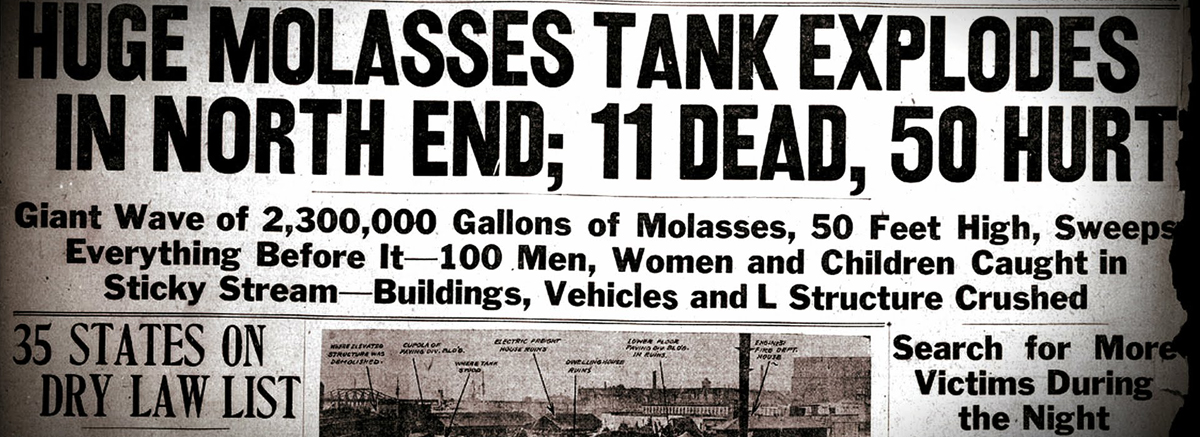Many things have happened in history that if no one had written it down, you would not believe that it happened. One of these events was the great molasses flood of 1919. While the title itself gives away what happened, what caused it, and its effects are still something to talk about.
On Boston’s north end, there was a massive 50-foot-tall tank of molasses constructed by the United States Industrial Alcohol Company in 1915. During this time, the demand for industrial alcohol had increased because of World War I. So, the company haphazardly created this tank to hold the vast amounts of molasses. Until they could be turned into alcohol, the molasses stood in a poorly constructed container, and on Jan. 15, 1919, the tank was at its limit.
During the middle of the day, the residents heard a familiar sound, the cracking of metal from the molasses container. They had just enough time to register the sound before the tank split open, sending 2.3 million gallons of molasses rushing down the streets at around 35 miles per hour. This wave of molasses covered the streets damaging property, injuring bystanders, and killing several.
This wave was so destructive that it destroyed quite literally anything in its path. Taking down the reenforced, elevated train platforms. Shattering horse carts, smashing light and telegraph poles.
The sheer amount of energy from the wave was so strong that it tore the nearby fire station from its foundation and moved it down the road. The fire station’s second story would also collapse because of the flood, trapping firemen inside. The molasses even seeped into homes causing several people to suffocate in the gooey mass.
As fast as the wave had come in, it settled down; covering the streets with sticky tar. Many of the people were still trapped by rubble and molasses. Firefighters, police and even sailors from the nearby U.S.S. Nantucket came to salvage the situation. But they needed to act fast, in the winter conditions of the day, being 40 degrees, the molasses began to harden. They quickly started to pull people from the crumbled buildings and molasses tar.
Over the course of several days, 21 people died, and 150 were injured because of the flood.
Many of the people were sadly only found after they had died. On a better note, firefighters figured out that one could clean away the molasses with salt water. With the city being right near a saltwater river, the cleanup was executed with more ease than originally thought possible.
In the aftermath, 119 lawsuits were filed against United States Industrial Alcohol.
But the company claimed that the disaster was caused by sabotage not negligence. But that was untrue, during the tank’s lifespan, citizens nearby had gotten used to the creaking of the metal container. At one point, an employe of United States Industrial Alcohol had informed corporate leaders of the tank’s instability, but they did nothing.
While a group of unknown individuals had threatened to blow up that tank, that is not what caused this tank to blow.
The trial dragged on for five years. Witnesses, survivors, United States Industrial Alcohol employees and even an explosives expert testified. In April of 1925, the court ruled that United States Industrial Alcohol was to blame for the disaster. They concluded that poor planning of the tank and the lack of oversight caused the tank to tear apart. United States Industrial Alcohol ended up paying flood victims and remaining family members $628,000, around $8 million in 2024 dollars.
This flood, while sounding like a hilarious event, is no laughing matter. People were suffocated, buildings crumbled, and the water was stained brown for months after the event. This terrible thing could have been avoided if the tank had been built properly and maintained. Instead, the people owning the company were more concerned about their profits than the stability of the tank.
It is important to remember that history must be recorded and learned, or we will repeat the same mistakes, causing unnecessary damage and loss. We should take care to keep ourselves and our environment safe, so we do not end up suffocating in a wave of molasses.
Categories:
Forgotten History: Boston’s Molasses Flood
Take Care Of The Environment; Avoid Suffocating In Molasses
Mieren Brown, Staff Writer
October 19, 2024
0
More to Discover



























